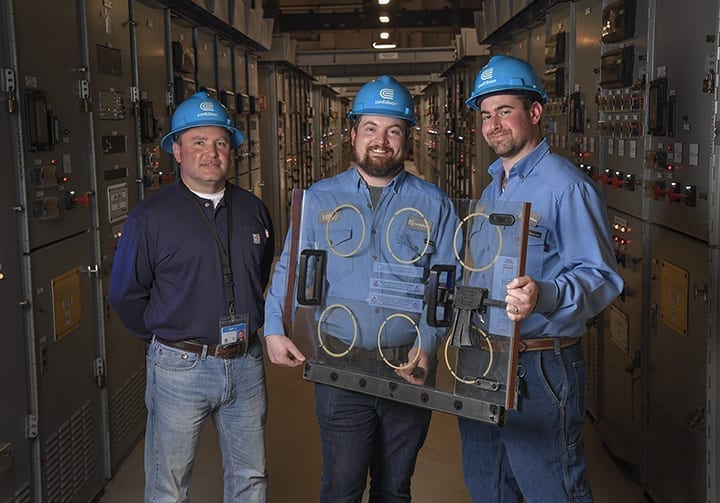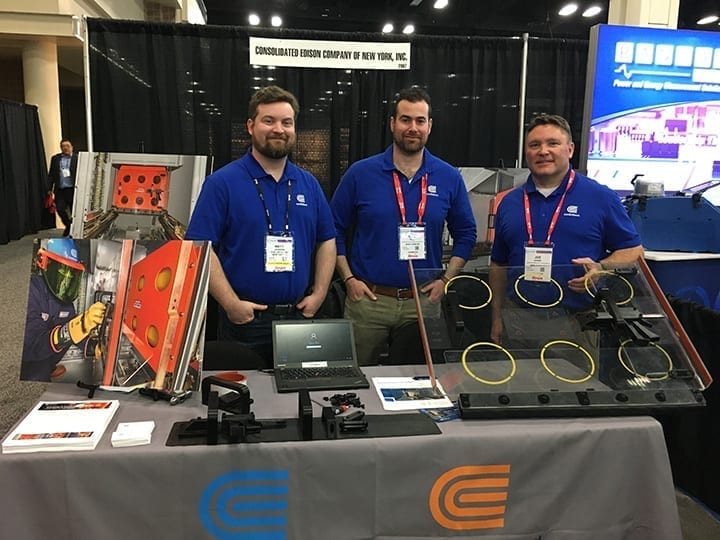Cubicle Inspection and Repair Safety Device Is a Winner
A team of innovators from Consolidated Edison (ConEd) took home the Real-World Safety Solutions award during the Experience POWER event on Sept. 28.
The invention the group created is called a Cubical Inspection and Repair Safety (CIRS) device. The team that designed and developed the solution includes Eric Fell, senior safety specialist with ConEd; Joe Szabo, senior engineer in ConEd’s Equipment and Field Engineering department; Matt Johnson, senior designer in ConEd’s Van Nest shop; Sergo Sagareli, senior engineer in ConEd’s Research and Development department; and Eric Davis, senior analyst in the company’s Innovation Hub. The CIRS device is a physical safety barrier designed for installation in a 4-kV to 27-kV switchgear cubicle.
“What it does is it creates an isolation plane so somebody working inside a switchgear cubicle, which has energized components behind a shutter assembly, can do almost all of the work that they would need in an outage, without an outage,” Fell said. “The main thing for us is the efficiency and the safety, with safety being always the first thing we do. And what this device does is it prevents someone from making incidental or accidental contact with energized components.”

Although all switchgear cubicles are similar, every manufacturer’s design is slightly different and has unique aspects. Fell explained that there is a shutter assembly in most designs, but there are often gaps where a person’s hand or a tool could make accidental contact with energized components. “That’s what we’re trying to avoid,” he said.
In addition to improving safety, the CIRS device has made ConEd’s maintenance program more efficient. Fell said the device allows more maintenance to get done, which improves system reliability and decreases costs.
“We’re seeing a lot of great results,” he said. “The device has been in the field for two years now. In 2019, I think we had about 14 to 16 use cases for corrective emergency repairs, and it was used on a regular basis for preventative maintenance, which was the first year it was out. And then this year alone, to date, we’ve exceeded those numbers for corrective maintenance. And it was used in the spring, and it will be used again in the next few weeks starting our preventative maintenance schedules.”
Creating a functional CIRS device clearly involved a team effort. The idea originated in May 2017 when Fell met Szabo at a breaker peer team meeting. They both saw the need to improve switchgear maintenance and their backgrounds paired well to develop a solution.
Johnson came into the picture soon thereafter. Szabo had worked with him on custom projects and knew he was a capable designer—someone who could use machine shop equipment and 3D printing to create prototypes. So, the threesome created a working model and brought it to Sagareli for tweaking. Sagareli sent the final design to an independent lab for testing and validation. Once the concept was proven, ConEd’s Innovation Hub, and specifically Davis, helped cross the “innovation valley of death,” that is, the gap between prototype and successful scaling and commercialization.
“Everything just kind of fell into place,” Szabo said. “The feedback that we’ve gotten from the field is just tremendous.”

The device is not yet available for purchase outside of the company, but ConEd’s team is working to partner with a manufacturer to get it on the market soon. “We’re just trying to find that manufacturing partner to take it on as their own product line and develop it for all our needs, as well as the industry,” Fell said. For their work, POWER and the Experience POWER conference recognized ConEd’s CIRS device team with the 2020 Real-World Safety Solutions award.
—Aaron Larson is POWER’s executive editor (@AaronL_Power, @POWERmagazine).